Mmsc407 exam questions - Study guides, Class notes & Summaries
Looking for the best study guides, study notes and summaries about Mmsc407 exam questions? On this page you'll find 53 study documents about Mmsc407 exam questions.
Page 4 out of 53 results
Sort by
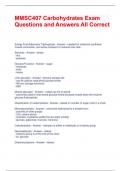
-
MMSC407 Carbohydrates Exam Questions and Answers All Correct
- Exam (elaborations) • 6 pages • 2024
-
Available in package deal
-
- $8.99
- + learn more
MMSC407 Carbohydrates Exam Questions and Answers All Correct Energy Fuel Adenosine Triphosphate - Answer-- needed for molecular synthesis, muscle contraction, and active transport of nutrients into cells Starches - Answer-- wheat - rice - potatoes Glucose/Fructose - Answer-- sugar - molasses - fruits - honey Liver glycogen - Answer-- primary storage site - can be used to raise blood glucose levels - 48 hour storage maximum - G6P Muscle glycogen - Answer-- makes up 2/3 of stored ...
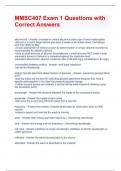
-
MMSC407 Exam 1 Questions with Correct Answers
- Exam (elaborations) • 23 pages • 2024
- Available in package deal
-
- $9.99
- + learn more
MMSC407 Exam 1 Questions with Correct Answers albuminuria - Answer--increase in urinary albumin is early sign of renal nephropathy -albumin is a much larger ketone and when it needs to be broken down, the kidneys lose their ability to filter -annual assessment of kidney function by determination of urinary albumin excretion is recommended for diabetic patients -looks at small amounts of albumin (microalbumin = small amounts NOT small in size) -persistent amount of albumin is compared a...
MMSC407 Exam 3-Acid Base Balance (30 questions and answers).
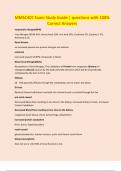
-
MMSC407 Exam Study Guide | questions with 100% Correct Answers
- Exam (elaborations) • 17 pages • 2024
-
- $12.89
- + learn more
nonprotein nitrogen(NPN) Urea Nitrogen (BUN) 45%, Amino Acids 20%, Uric Acid 20%, Creatinine 5%, Creatine 1-2%, Ammonia 0.2% Renal disease an increased plasma non-protein nitrogen can indicate azotemia increased amount of NPN compounds in blood Blood Urea Nitrogen(BUN) Biosynthesis of Urea Nitrogen, The catabolism of Protein from exogenous (dietary) or endogenous(tissue) sources by the body will yield ammonia which will be enzymatically complexed by the liver to form urea.
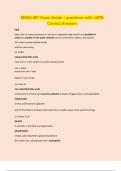
-
MMSC407 Exam Guide | questions with 100% Correct Answers
- Exam (elaborations) • 17 pages • 2024
- Available in package deal
-
- $12.99
- + learn more
lipid fatty, oily, or waxy substances or animal or vegetable origin which are insoluble in water but soluble in non-polar solvents such as chloroform, ethers, and alcohol NO carbon-carbon double bonds solid at room temp ex. butter unsaturated fatty acids have one or more carbon to carbon double bonds one = mono more than one = poly liquid at room temp ex. olive oil
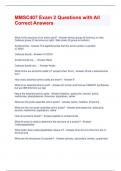
-
MMSC407 Exam 2 Questions with All Correct Answers
- Exam (elaborations) • 12 pages • 2024
- Available in package deal
-
- $9.49
- + learn more
MMSC407 Exam 2 Questions with All Correct Answers What is the structure of an amino acid? - Answer-Amino group (N-terminus on left), Carboxyl group (C-terminus on right), Side chain (R-group on bottom) Amide bonds - Answer-The peptide bonds that link amino acids in a protein (C-NH2) Carboxyl bonds - Answer-C-COOH Amide bonds are... - Answer-Basic Carboxyl bonds are... - Answer-Acidic What forms are all amino acids in? (except when R=H) - Answer-Chiral L-stereoisomer form How many es...
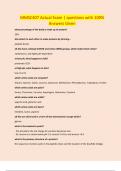
-
MMSC407 Actual Exam | questions with 100% Answers Given
- Exam (elaborations) • 17 pages • 2024
- Available in package deal
-
- $12.99
- + learn more
what percentage of the body is made up of protein? 20% AAs attach to each other to make proteins by forming... peptide bonds all AAs have carboxyl (COOH) and amino (NH2) groups, which makes them what? zwitterionic, and highly pH dependent at low pH, what happens to AAs? protonate COO-
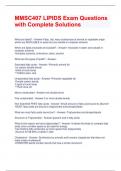
-
MMSC407 LIPIDS Exam Questions with Complete Solutions
- Exam (elaborations) • 13 pages • 2024
- Available in package deal
-
- $9.69
- + learn more
MMSC407 LIPIDS Exam MMSC407 LIPIDS Exam Questions with Complete Solutions What are lipids? - Answer-Fatty, oily, waxy substances of animal or vegetable origin which are INSOLUBLE in water but are soluble in nonpolar solvents When are lipids insoluble and soluble? - Answer--Insoluble in water and soluble in nonpolar solvents -Nonpolar solvents: chloroform, ether, alcohol What are the types of lipids? - AnswerSaturated fatty acids - Answer--Primarily animal fat -no carbon double bonds -...
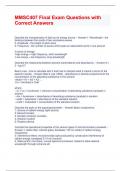
-
MMSC407 Final Exam Questions with Correct Answers
- Exam (elaborations) • 31 pages • 2024
- Available in package deal
-
- $10.89
- + learn more
MMSC407 Final Exam Questions with Correct Answers Describe the characteristics of light as an energy source. - Answer-1. Wavelength - the distance between the crests of two successive waves 2. Amplitude - the height of each wave 3. Frequency - the number of waves which pass an observation point in one second In terms of energy: -High energy = high frequency, short wavelength -Low energy = low frequency, long wavelength Describe the relationship between percent transmittance and absorb...
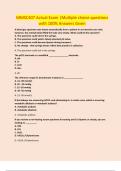
-
MMSC407 Actual Exam |Multiple choice questions with 100% Answers Given
- Exam (elaborations) • 14 pages • 2024
- Available in package deal
-
- $12.89
- + learn more
A blood gas specimen was drawn anaerobically from a patient in an intensive care unit; however, the arterial blood filled the tube very slowly. What could be the outcome? A. The specimen could clot in the syringe. B. The specimen could yield a falsely elevated pH value. C. The specimen could become lipemic during transport. D. No change - slow syringe draws reflect best practice in collection. A. The specimen could clot in the syringe. The pCO2 electrode is a modified ________________ ele...

Study stress? For sellers on Stuvia, these are actually golden times. KA-CHING! Earn from your study resources too and start uploading now. Discover all about earning on Stuvia



